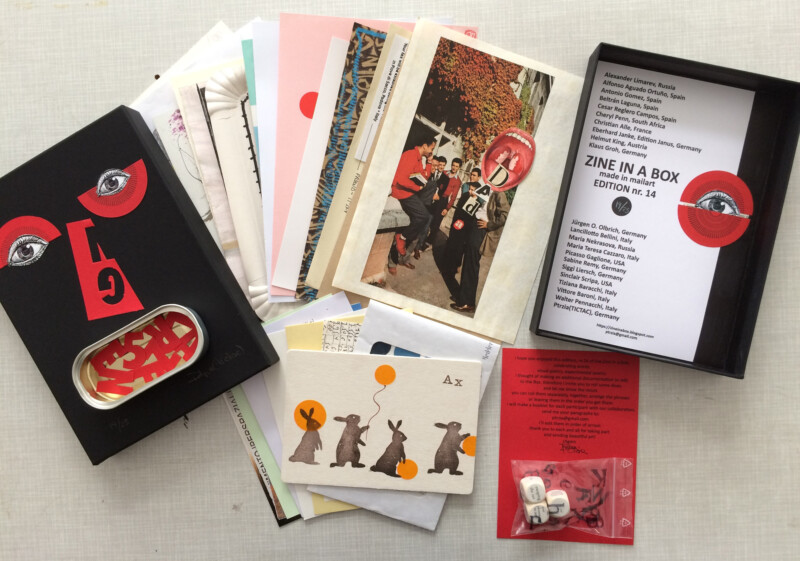In Tictac Patrizias “Zine in a box“ Nr. 14 befand sich eine Einladung, an einem „Würfelspiel“ teilzunehmen. Auf den von ihr vorbereiteten Würfeln befanden sich Satzfragmente, mit denen man durch einen Wurf ein zufälliges dadaistisches Gedicht verfasste, das man notieren und an sie emailen sollte.
In TicTacs Hintergrundinformationen zu diesem Projekt ist zu lesen:
„Würfel als Ausschnitte
Die Ausschneidetechnik ist eine aleatorische [vom Zufall abhängige, auf Zufall beruhende, dem Zufall überlassene] literarische Methode, bei der ein Text zerschnitten und anders angeordnet wird, wodurch ein neuer Text entsteht.
Diese Methode geht auf den Dadaismus in den 1920er Jahren mit Tristan Tzaras Methode „Wie man ein dadaistisches Gedicht verfasst“ zurück und wurde 30 Jahre später von William S. Burroughs populär gemacht.
Aleatorisch, weil sie wie ein Würfelwurf vom Zufall abhängt“ (siehe Foto)
Das hat mich neugierig gemacht, denn mir war die Methode von Tristan Tzara nicht bekannt. Ich habe dazu folgendes gefunden:
„Wie man ein dadaistisches Gedicht verfasst
(Methode von Tristan Tzara)
Um ein dadaistisches Gedicht zu machen:
– Nimm eine Zeitung.
– Nimm eine Schere.
– Wähle einen Artikel der so lang ist wie Du vorhast, Dein Gedicht zu verfassen.
– Schneide den Artikel aus.
– Dann schneide jedes der Wörter aus, aus denen dieser Artikel besteht, und packe sie in eine Tüte.
– Schüttel sie leicht.
– Dann nimm die Fetzen nacheinander in der Reihenfolge heraus, in der sie die Tüte verlassen haben.
– Übernimm alles gewissenhaft.
Das Gedicht wird Dir ähnlich sein.
Und hier bist Du – ein Schriftsteller, unendlich originell und mit einer Sensibilität ausgestattet, die über das Verständnis des Vulgären hinaus reizvoll ist.
–Tristan Tzara“ (Quelle)
Aus allen Einsendungen hat TicTac nun ein Magazin gemacht, das „Zine in a box No 14 – The Dice Roll Project – Magazine“. Noch habe ich es wegen der Corona-bedingten Einschränkungen bei der Post nicht erhalten – aber TicTac hat mir freundlicherweise schon einmal einige Fotos für diesen Artikel zur Verfügung gestellt. Wie man darauf erkennen kann, sind die Gedichte unterschiedlich lang – meins ist absolut minimalistisch – drei Würfel ergaben einen Dreizeiler.
Es hat mir Spaß gemacht, an diesem Projekt teilzunehmen – und ich freue mich sehr auf das Magazin.
english version:
In Tictac Patricia’s „Zine in a box“ No. 14 there was an invitation to participate in a „game of dice“. On the dice she had prepared there were fragments of sentences with which one could write a random Dadaist poem by rolling them, which one should note down and email to her.
See TicTac’s background information about this project:
„Dices at cut-outs
The cut-out technique is an aleatoric literary method [based on coincidence, left to chance] in which a text is cut up and arranged differently, creating a new text.
This method is traced back to Dadaism in the 1920´s with Tristan Tzara’s method „To Make a Dadaist Poem“ and it was made popular 30 years later by William S. Burroughs.
Aleatoric, because it depends on chance just like a throw of a dice ….“ (see photo)
This made me curious, because I was not familiar with the method of Tristan Tzara. I have found the following:
„How to Make a Dadaist Poem
(method of Tristan Tzara)
To make a Dadaist poem:
– Take a newspaper.
– Take a pair of scissors.
– Choose an article as long as you are planning to make your poem.
– Cut out the article.
– Then cut out each of the words that make up this article and put them in a bag.
– Shake it gently.
– Then take out the scraps one after the other in the order in which they left the bag.
– Copy conscientiously.
– The poem will be like you.
– And here are you a writer, infinitely original and endowed with a sensibility that is charming though beyond the understanding of the vulgar.
–Tristan Tzara“ (Source)
TicTac has now made a magazine out of all submissions, the „Zine in a box No 14 – The Dice Roll Project – Magazine“. I haven’t received it by mail yet due to the Corona-related restrictions – but TicTac has kindly provided me with some of the photos for this article. As you can see on it, the poems are of different lengths – mine is absolutely minimalistic – three cubes resulted in a three-line.
I enjoyed participating in this project – and I’m really looking forward to the magazine.










Thank you very much Sabine for the exhaustive post on the Dice Roll Project. it was a great complement to the Box concept too, and an excellent collection of poems, lyrics, made exciting from the variety of possibilities and the individual interpretations. thank you for your participation! I like short poems, they are very intense in their minimalism, like yours.
Many thanks Tictac for stopping by and for leaving the nice comment!
Looking forward to receiving the zine – so curious to read the others dice poems.